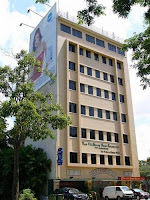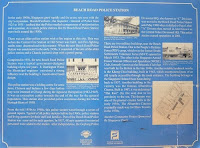Beach Road is one of the early roads developed in Singapore and appears in George Coleman’s 1836 Map of Singapore. The road was actually a coastal road fronting the sea coast in the early decades of the colonial city. Sir Stamford Raffles reserved Beach Road for the residences of the European merchants. Apparently it was common for the water to come up and over Beach Road at high tide, before the land now in front of Beach Road was reclaimed. Apart from houses, there were hotels, clubs and bars as well. The area was also the scene of frequent brawls, as in the days before Tanjong Pagar became the port area, European sailors on shore leave would make for Beach Road.
As soon as I reached Bugis MRT station, I headed straight to the site where the New 7th storey Hotel once stood. It was announced on June 26, 2008 that the hotel would be demolished to make way for the new Bugis MRT station for the Downtown Line. I knew what I would be seeing.




 In the 70’s, the pub in the hotel was one of the hottest nightspots in town. It is also known as the leaning hotel of Singapore as it tilts. Built by the late property magnate Wee Thiam Siew, who also owned the Ban Leong Group that distributed 555 Brand cigarettes, the top floor once offered panoramas of the seascapes.
In the 70’s, the pub in the hotel was one of the hottest nightspots in town. It is also known as the leaning hotel of Singapore as it tilts. Built by the late property magnate Wee Thiam Siew, who also owned the Ban Leong Group that distributed 555 Brand cigarettes, the top floor once offered panoramas of the seascapes.
.

 ^The DHL Balloon (2) was first located on Tan Quee Lan Street near the New 7th Storey Hotel and the Bugis MRT Station. Launched in 27 April 2006 at a cost of $2.5 million, this French balloon was inflated on 19 April 2006 by 2200 hrs. Requiring 6,500 cubic metres of helium, it took more than 12 hours and 40 crewmembers to inflate. Jointly operated by Aerophile Balloon (S) Pte Ltd and Vertical Adventure Pte Ltd, the Balloon could carry a maximum of 29 passengers. Flight time was approximately 10-minutes and passengers would be floating 40-storeys high. When the DHL Balloon's lease on this site expired in August 2008, the URA terminated the lease as it has plans for the site.
^The DHL Balloon (2) was first located on Tan Quee Lan Street near the New 7th Storey Hotel and the Bugis MRT Station. Launched in 27 April 2006 at a cost of $2.5 million, this French balloon was inflated on 19 April 2006 by 2200 hrs. Requiring 6,500 cubic metres of helium, it took more than 12 hours and 40 crewmembers to inflate. Jointly operated by Aerophile Balloon (S) Pte Ltd and Vertical Adventure Pte Ltd, the Balloon could carry a maximum of 29 passengers. Flight time was approximately 10-minutes and passengers would be floating 40-storeys high. When the DHL Balloon's lease on this site expired in August 2008, the URA terminated the lease as it has plans for the site.
^Icon @ Bugis Point (3) was opened on New Year’s Eve 2006. Set to make waves in the local street fashion scene, this 7-storey building consists on 5 levels of Hongkong/Harajuku-styled fashion retail outlets. There are about 8 shops on each floor, all not much bigger than the hall of a 3-room HDB flat.
^Beach Road Police Station (4). In the early 1900s, Singapore grew rapidly and the crime rate rose with the city’s expansion. Harold Fairburn, the Inspector–General of Police from 1925 to 1935, realised that the Police needed a programme of modernization and expansion. As a result, police stations like the Beach Road Police Station were built around the 1930s.
There was an older police station with a fire engine at this site. This was before the Central Fire Station at hill Street was built, and fire-fighting outfits were decentralized in this manner. When the new Beach Road Police Station was constructed in the early 1930s, it consisted of the site of the older police station and a Chandu (opium) shop with a petrol pump.
Completed in 1931, the new Beach Road Police Station was a typical government-designed building of pre-war years. This police station ceased operations in 2001.


^This is the location of the famous Alhambra Cinema (5). The cinema was built in 1907 by motion picture industry pioneer Tan Cheng Kee, building renamed Gala Theatre owned by Cathay Organisation), next to it was the Marlborough Cinema, and alongside it, the original "Satay Club" at hoi How Road, which was also the bus depot for the No. 1, red and black colour bus of Tay Koh Yat Bus Company. Alhambra Cinema was nicknamed "Hai Kee" (by the sea) due to its proximity to the sea. This theatre was one of the pioneer cinema halls in the early 1930s. The Alhambra became the first Singapore cinema to have air conditioning and played films like Errol Flynn’s Robin Hood to packed sessions. The Alhambra Cinema eventually made way for Shaw Towers in the 1970s.
^Kheng Chiu Building (6), built in 1963, which incorporated parts of an old temple accessible through the main entrance. The building belongs to the Singapore Hainan Hwee Kuan dating back to 1857.
^The National Library Building (7), opened to the public on 22 July 2005, at 100 Victoria Street is the largest library in Singapore. The building consists of two 16-storey blocks linked by ‘sky bridges’ on every level. The New National Library Building is a marriage of two libraries: the Central Lending Library (where books can be borrowed) is on Basement 1, and the Lee Kong Chian Reference Library (where materials are for reference within the library only) occupies Levels 7 to 13. Look out also for Permanent Exhibitions (Levels 5 and 11).
^Bras Basah Complex (8) houses an array of art, book and music shops with its 5 stories. Under the urban renewal plan, Bras Basah Complex was built in 1980 as a 25 storey high building, with the 1st to 5th storeys being utilized for commercial purpose and the rest for residential flats. The other name for Bras Basah Complex is “City of
^The Mint Museum of Toys (9) showcases a world class collection of toys that spans more than 25 countries and over 100 years. Many toys are extremely rare and in mint condition, often displayed with their original packaging. Opening hours 9.30am to 6.30pm daily. Entrance fee: Adult-$10.00 & Child 2 to 12 years old and Senior citizens - $5.00.


The Singapore Armed Forces Warrant Officers and Specialists Club (11).






















No comments:
Post a Comment